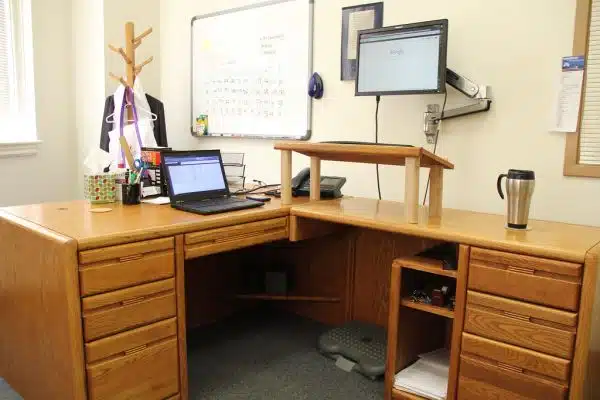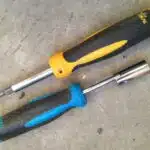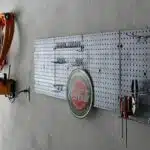Standing desks have become increasingly popular in recent years, as more people look for ways to improve their health and productivity while working. While there are many standing desk options available on the market, building your own DIY standing desk can be a fun and rewarding project that allows you to customize the desk to your specific needs and preferences.
As a furniture builder and designer, I have seen the benefits of standing desks firsthand. Not only do they promote better posture and reduce the risk of back pain, but they also increase energy levels and improve focus. In this article, I will provide step-by-step instructions on how to build a DIY standing desk that is both aesthetically pleasing and functional. Whether you are looking to save money or simply enjoy the satisfaction of building something yourself, this guide will help you create a workspace that supports your health and productivity.
Materials And Tools Needed
Did you know that sitting for long periods of time can lead to a host of health problems such as obesity, heart disease, and even cancer? One solution is a standing desk, which can help alleviate some of these risks. Building your own DIY standing desk is not only cost-effective but also allows for customization to fit your specific needs.
To create your own standing desk, you’ll need materials such as plywood, screws, and brackets. Tools needed include a saw, drill, and level. The cost of materials will vary depending on the type of wood and finishing options chosen. However, building your own desk can be significantly cheaper than purchasing one from a retailer.
Aside from cost savings, building your own standing desk also allows for unique finishing options such as staining or painting the wood to match existing furniture. By choosing to build your own standing desk rather than purchasing one pre-made, you have control over the appearance and functionality of the final product. In the next section, we’ll discuss how to choose the right height for your DIY standing desk based on your individual needs and preferences.
Choosing The Right Height For Your Desk
After gathering all the necessary materials and tools, it is important to determine the proper height for your standing desk. The correct height will promote proper posture and provide numerous health benefits. Improper desk height can lead to neck, shoulder, and back pain, as well as eye strain.
To determine the right height for your desk, first stand up straight with your arms at a 90-degree angle. Measure from the floor to your elbows and subtract one inch. This will give you an approximate height for your desktop surface. However, keep in mind that different tasks may require different heights. For example, typing on a keyboard may require a lower surface than drawing or writing.
In addition to proper height, standing desk accessories and ergonomic additions can further improve posture and promote better health while working. Anti-fatigue mats can help reduce leg pain from standing for long periods of time, while monitor stands can elevate screens to eye level to prevent neck strain. It is important to consider these additions when building your own standing desk for maximum comfort and productivity.
Moving on from choosing the right height comes measuring and cutting the wood needed for constructing your DIY standing desk. By carefully measuring and cutting each piece of wood according to your design plans, you can ensure that each component fits together perfectly during assembly.
Measuring And Cutting The Wood
Accurate measurements are essential for any furniture build, and there are a variety of tools available to measure length, width, and thickness. For cutting the wood, saws, jigsaws, and miter saws are all effective tools to consider. Different types of wood can be used in the furniture build, including hardwood, softwood, and plywood. Hardwoods are typically denser and sturdier, while softwoods are generally easier to saw and shape. Plywood is a composite material made of thin layers of wood that are glued together, making it a more cost-effective option for certain projects. It is important to consider the characteristics of the wood when selecting the appropriate saw and cutting technique.
Measuring Tools
Accurate measurements are crucial when building a DIY standing desk. To ensure precision, it’s essential to use the right measuring tools. Different types of measurements require different tools, so it’s best to have a variety on hand. A tape measure is a must-have for measuring lengths and widths, while a square is necessary for checking angles and ensuring straight cuts.
One of the most common measuring mistakes to avoid is not double-checking your measurements before cutting the wood. This can lead to costly errors that will affect the entire project’s outcome. Another mistake is relying solely on one measuring tool; instead, use multiple tools to cross-check and confirm each measurement. Inaccurate measurements can result in uneven cuts, misaligned joints, and overall poor quality workmanship.
Measuring tools are essential for any woodworking project, especially when building a DIY standing desk. Take the time to familiarize yourself with different types of measurements and corresponding tools to avoid costly mistakes. Remember always to double-check your measurements before cutting and never rely solely on one tool. With careful attention to detail and precision, you’ll be well on your way to creating a sturdy and functional standing desk that will serve you for years to come.
Cutting Tools
When building a DIY standing desk, measuring and cutting the wood are crucial steps in achieving a functional and sturdy piece of furniture. Accurate measurements require the appropriate tools, but cutting the wood also requires the right equipment to ensure precision and safety. Cutting tools come in various forms and sizes, each with its specific purpose.
There are several cutting techniques when working with wood, such as cross-cutting, ripping, and bevel-cutting. Each technique requires different types of saws that can make clean and straight cuts on different angles. However, using these cutting tools should come with safety precautions to avoid any injuries or accidents. Wear protective gear such as gloves, goggles, and ear protection when operating saws.
When choosing cutting tools for your DIY standing desk project, consider their quality in terms of durability and accuracy. Investing in high-quality tools may cost more initially but will save you money in the long run by avoiding frequent replacements or repairs. Additionally, proper maintenance of the tools is essential to prolong their lifespan and ensure their accuracy over time.
Wood Types
As a furniture builder, selecting the right wood type is crucial in achieving the desired outcome of your DIY standing desk project. Different wood types have distinct properties that affect their strength, durability, and appearance. The most common wood types used in furniture making are hardwoods and softwoods. Hardwoods come from deciduous trees such as oak, maple, and cherry, while softwoods come from coniferous trees like pine and cedar.
When choosing a wood type for your project, consider its benefits. Hardwoods are known for their durability, density, and resistance to wear and tear. They also have an elegant look that enhances the aesthetic appeal of furniture pieces. Softwoods are lightweight, easy to work with using traditional tools like saws and drills, and cost less than hardwoods. They are perfect for structural components like legs or supports.
Lastly, knowing what wood type to use for each part of your standing desk can make a difference in its overall quality and longevity. For instance, you can use hardwoods for the tabletop or working surface because it needs to be strong enough to support weighty items like computers or books. Meanwhile, softwoods can be used as supportive structures that do not need to bear heavy loads such as legs or frames. Understanding these wood types’ characteristics is essential in building a functional and beautiful DIY standing desk that will serve you well for years to come.
Sanding And Finishing The Wood
How can you ensure that your DIY standing desk looks professional and lasts a long time? One of the most important steps is sanding and finishing the wood. Here are some tips to help you achieve a polished look.
First, begin by smoothing out any rough spots or edges with sandpaper. Use a coarse grit to remove any roughness, then switch to finer grits to achieve a smooth finish. Sand in the direction of the grain to avoid scratches or other marks that can detract from the final appearance.
Once you have sanded the wood, it’s time to apply a stain or varnish. Staining allows you to add color while showcasing the natural grain of the wood. Varnishing will give your desk added protection against wear and tear. Be sure to apply multiple coats for maximum durability, following proper drying times between each coat. For best results, use high-quality products and follow manufacturer instructions carefully.
Now that you have sanded and finished your wood with appropriate varnishing techniques, it’s time to move on to assembling the legs and frame. Keep in mind that this step requires precision and accuracy to ensure stability and safety when using your standing desk. With careful attention to detail, you’ll be well on your way toward creating a beautiful and functional workspace customized just for you!
Assembling The Legs And Frame
- To assemble the legs and frame of a standing desk, it is important to first gather the necessary tools and materials.
- These may include a drill and screws, a saw and clamps, and the appropriate materials for the legs and frame.
- The legs and frame need to be securely fastened to one another for the desk to be stable.
- This can be done by drilling screw holes and using screws, or by clamping the parts together and reinforcing them with a saw.
Gathering Tools And Materials
To begin building your own DIY standing desk, the first step is to gather all of the necessary tools and materials. Sourcing high-quality materials is crucial in ensuring that your desk will be sturdy and long-lasting. Consider using hardwood or plywood for the desktop, as well as steel pipes for the legs and frame. When sourcing materials, it is important to keep in mind the dimensions of your workspace and ensure that you have enough material to create a stable structure.
In addition to sourcing materials, it is also important to take proper tool safety precautions when assembling the legs and frame of your standing desk. This includes wearing protective gear such as gloves and goggles, as well as taking care when using power tools such as saws and drills. It is also important to read all instructions carefully before beginning work, and to double-check all measurements before making any cuts or attaching any pieces.
Overall, gathering tools and materials for your DIY standing desk can be an exciting process that allows you to customize your workspace exactly how you want it. By taking care when sourcing materials and following tool safety precautions during assembly, you can ensure that your desk will not only look great but be functional for years to come.
Securing The Legs And Frame
Now that you have gathered all the necessary tools and materials for your DIY standing desk, it’s time to move on to assembling the legs and frame. One of the most important aspects of this process is ensuring leg stability and proper weight distribution, as an unstable desk can be unsafe and uncomfortable to work at.
To ensure leg stability, it is important to choose sturdy materials such as steel pipes that can support the weight of the desktop and any items placed on it. When attaching the legs to the frame, make sure that they are securely fastened using bolts or screws. Additionally, if you plan to use adjustable legs, make sure that they are locked in place once adjusted to prevent any wobbling or instability.
Proper weight distribution is also key in creating a stable standing desk. Make sure that the weight of the desktop is evenly distributed across all four legs or supports. If necessary, add additional supports or braces to help distribute weight more evenly. By taking these steps during assembly, you can help ensure that your DIY standing desk will be comfortable and safe to use for years to come.
Attaching The Desktop To The Frame
Once the legs and frame are assembled, the next step is to attach the desktop to the frame. This is where you get to personalize your DIY standing desk by selecting the type of wood or material for your desktop. It’s important to make sure that the desktop is sturdy enough to hold all of your equipment and belongings.
One option for attaching the desktop to the frame is using screws or bolts. This method ensures a secure fit, but it may not be easily adjustable if you need to change the height of your desk later on. Another alternative attachment is using brackets or clips, which allow for more adjustability but may not provide as strong of a connection between the desktop and frame.
Once your desktop is attached securely, it’s time to add any decorative finishes you desire. This could include staining or painting your wood, adding trim around the edges, or even covering it with a protective coating like polyurethane. These finishing touches will not only enhance the aesthetic appeal of your DIY standing desk but also protect it from wear and tear over time.
As you move onto adding a keyboard tray, consider what materials would work best for this feature and how it will affect the overall design and functionality of your desk. With careful consideration and attention to detail in each step, you’ll have a custom-built standing desk that fits all of your needs and preferences.
Adding A Keyboard Tray
Like a conductor leading an orchestra, every component of a standing desk must work together harmoniously. Adding a keyboard tray is essential to the ergonomic functionality of your workspace. With mounting options for both under-desk and above-desk placements, you can customize your setup to suit your needs.
Ergonomic considerations are crucial when designing a standing desk. A poorly positioned keyboard can lead to wrist pain and discomfort, which can ultimately hinder productivity. By adding a keyboard tray, you can adjust its position to fit your body’s unique needs and ensure proper alignment.
When choosing your mounting option, consider the overall aesthetic of your desk as well. An under-desk mount creates clean lines and offers more space on top for other items, while an above-desk mount provides easy access and adds dimension to your workstation. Whichever option you choose, make sure it complements the rest of your standing desk design seamlessly.
Transitioning from the addition of a keyboard tray, installing cable management is the next step in creating an organized and clutter-free workspace.
Installing Cable Management
When constructing a DIY standing desk, it is important to choose a cable management option that best suits the desk and user’s needs. This could include cable baskets, cord organizers, and other cable routing solutions. Once the cable management option has been chosen, it is essential to ensure the proper installation of the solution. This includes securely attaching the cable management solution to the desk, as well as routing cables in an organized and safe manner. Furthermore, it is important to ensure the cable management solution does not impede the user’s ability to adjust the desk height.
Choosing Cable Management Options
When it comes to building a DIY standing desk, one crucial aspect that is often overlooked is cable management. A cluttered workspace not only looks unsightly but can also be hazardous. Choosing the right cable management options can help keep your desk organized, minimize tripping hazards, and prolong the lifespan of your electronics.
One popular option for managing cables is using a cable sleeve. Cable sleeves are made of flexible neoprene or nylon material that can hold several cords together. They come in different sizes and colors to match your desk’s design, and some even have zippered closures for easier access. Another popular option is using desk grommets, which are small circular holes in the desktop where cables can pass through. Desk grommets come in various materials such as plastic or metal and can be installed during the desk’s construction.
Before choosing a cable management option, consider how much space you need for your cables and devices. Determine if you need a single cable sleeve or multiple ones or if you require multiple desk grommets placed strategically across the desktop. Also, factor in the cost of each option and their ease of installation compared to other alternatives. By carefully selecting the right cable management system for your DIY standing desk, you can create a clean and functional workspace that will increase productivity and creativity without compromising safety or aesthetics.
Installing Cable Management Solutions
Installing cable management solutions is an essential part of creating a functional workspace, especially when building a DIY standing desk. It involves using various techniques to organize and tidy up cables, which can be unsightly and even dangerous when left unmanaged. One popular method is using cable ties to bundle cables together, reducing clutter and making it easier to identify specific cords. Cable ties come in different sizes and materials, allowing them to be tailored to the specific needs of the workspace.
Another option for installing cable management solutions is cable channels installation. Cable channels are plastic or metal strips that attach to the underside of the desktop, providing a pathway for cables to run through while keeping them hidden from view. This method works well for those who require multiple devices or have many cables running through their workspace. They can be installed during the desk’s construction or added later as an upgrade.
Overall, installing cable management solutions should not be overlooked when building a DIY standing desk. With various options such as cable ties usage and cable channels installation available, it is essential to choose the right one for your needs based on factors such as cost, ease of installation, and aesthetic appeal. By organizing your cables efficiently, you can create a safer and more productive workspace that will serve you well in the long run.
Adding Adjustable Feet
One of the main benefits of adding adjustable feet to your DIY standing desk is that it allows you to change the height and level of your desk. This is particularly helpful if you have an uneven floor or if you want to adjust the height of your desk as you switch between sitting and standing throughout the day. By installing adjustable feet, you can easily make these adjustments without having to disassemble or rebuild your entire desk.
There are several DIY solutions for adding adjustable feet to your standing desk. One option is to use furniture glides, which are small pads that attach to the bottom of your desk legs and can be adjusted in height. Another option is to use threaded inserts, which allow you to screw in adjustable feet directly into your desk legs. Regardless of which solution you choose, it’s important to make sure that the adjustable feet are securely attached and do not wobble or shift when pressure is applied.
When choosing adjustable feet for your DIY standing desk, it’s important to consider both functionality and aesthetics. While some types of adjustable feet may provide more stability than others, they may not look as sleek or modern on your finished product. Conversely, some types of adjustable feet may look better but may not provide as much stability as others. Ultimately, the choice will depend on your personal preferences and needs.
As we move forward with building our DIY standing desks, it’s important not only to consider how we can improve their functionality but also how we can ensure their safety and stability. In order to do so, we must test our desks thoroughly once they are complete by applying pressure from various angles and checking for any wobbling or shifting. In the next section, we will explore how we can test the stability of our desks in greater detail.
Testing The Stability Of Your Desk
One of the most important aspects of building a DIY standing desk is ensuring its stability. Stability testing is crucial to ensure that your desk will not wobble or tip over, which could cause damage to your computer or other equipment, as well as put you at risk of injury. There are several methods you can use to test the stability of your desk.
First, try pushing on the desk from different angles with varying amounts of force. If the desk wobbles or tips over easily, it may need additional bracing or reinforcement. Another way to test stability is to place weights on top of the desk and see if it can support them without bending or buckling.
To further ensure the stability of your DIY standing desk, consider incorporating these tips:
- Choose sturdy materials such as hardwood or plywood for the desktop and legs.
- Use high-quality screws and hardware to secure all components together.
- Add braces or crossbars for extra support.
- Consider using adjustable feet to level the desk on uneven surfaces.
By taking these steps and conducting thorough stability testing, you can create a safe and functional DIY standing desk that will serve you well for years to come.
Moving forward, there are also several tips for maintaining your DIY standing desk that can help prolong its lifespan and keep it in good condition.
Tips For Maintaining Your Diy Standing Desk
When constructing a DIY standing desk, it is important to consider ergonomic posture, as it is essential to prevent injury and promote a healthy workspace. Monitor adjustments should also be considered, with desk height, screen distance, and screen angle all needing to be adjusted to reduce the risk of neck and eye strain. A good ergonomic posture for a standing desk is to have the elbows bent at 90 degrees and the wrists in a neutral position. Monitor adjustments should also ensure that the user’s eyes are level with the top of the monitor to reduce eye strain.
Ergonomic Posture
The importance of ergonomic posture cannot be overstated when it comes to standing desks. As a furniture builder and designer, I can attest that proper posture is key to maximizing the benefits of standing desks while minimizing the risks of strain or injury. Office exercises are a great way to maintain good posture throughout the workday.
When using a standing desk, it is important to keep your shoulders relaxed, back straight, and feet flat on the floor. This will help prevent shoulder and neck pain as well as lower back discomfort. Additionally, taking breaks to stretch or move around can help improve circulation and reduce muscle fatigue.
The benefits of standing desks are numerous, but they can only be fully realized with proper ergonomic posture. By incorporating office exercises and maintaining good posture throughout the workday, you can make the most out of your DIY standing desk while improving your overall health and well-being.
Monitor Adjustments
When it comes to DIY standing desks, proper ergonomic positioning is crucial for maintaining good posture and reducing the risk of strain or injury. In addition to keeping your shoulders relaxed, back straight, and feet flat on the ground, adjusting the height and position of your monitor is also essential. As a furniture builder and designer, I recommend taking the time to make these adjustments to ensure optimal comfort and productivity throughout your workday.
To adjust the height of your monitor, start by positioning it at eye level. This will help prevent neck strain and reduce eye fatigue. If you find that you need to look up or down to view your screen, adjust the height accordingly until you can comfortably see everything on your monitor without having to tilt your head up or down. Additionally, make sure that the distance between your eyes and the screen is about arm’s length away to avoid eye strain.
Aside from adjusting the height of your monitor, ergonomic positioning is also important for preventing discomfort when using a standing desk. Ensure that your keyboard is positioned at elbow height and that it is angled slightly downwards towards you. This will keep your wrists in a neutral position while typing and reduce tension in your arms and shoulders. By making these simple adjustments, you can improve your overall well-being while maximizing the benefits of using a DIY standing desk.
Personalizing Your Desk With Accessories
Maintaining your DIY standing desk is essential, but it’s also important to personalize it with accessories that meet your needs. Desk accessories can help improve your productivity and comfort by providing additional storage, cable management solutions, and lighting options.
When selecting desk accessories, consider ergonomic factors such as the height and angle of your computer monitor and keyboard. A monitor stand or arm can help you adjust the height of your screen to reduce neck strain, while a keyboard tray or adjustable keyboard stand can help you type more comfortably.
Additionally, there are numerous desk accessories available that can help improve your posture and promote movement while working. Options range from balance boards and footrests to standing mats and anti-fatigue mats that provide cushioning for your feet during long periods of standing. By incorporating these ergonomic considerations into the design of your standing desk, you’ll be able to work more comfortably and efficiently.
As you continue to explore ways to personalize your DIY standing desk, consider incorporating a treadmill or bike into your workspace. These innovative additions can help improve circulation, burn calories, and boost energy levels throughout the day. With a little creativity and experimentation, you’ll be able to create a customized workspace that not only meets your functional needs but also enhances your overall well-being.
Incorporating A Treadmill Or Bike
When choosing a treadmill or bike for a standing desk, factors such as size, noise level, and weight should be taken into consideration. The installation of the treadmill or bike should be planned out ahead of time, ensuring there is sufficient room for the device and that the necessary tools are available. Additionally, the height of the treadmill or bike should be adjusted to the user’s needs to ensure optimal comfort and efficiency. Finally, any electrical and/or mechanical components should be checked prior to use to ensure proper operation.
Choosing A Treadmill/Bike
Setting up a DIY standing desk can be challenging yet rewarding. One way to incorporate movement into the workspace is by adding a treadmill or bike desk. It’s important to choose the right equipment that suits your needs and budget.
When it comes to choosing a treadmill desk, consider its benefits. It allows you to stay active while working, which can improve your cardiovascular health and reduce the risks of a sedentary lifestyle. Treadmill desks come in different sizes, speeds, and features. Some models have adjustable height options and built-in work surfaces for laptops or monitors. It’s essential to choose one that fits your body type and work requirements.
If you prefer biking over walking, then bike desk options are available as well. A bike desk combines exercise with productivity, allowing you to burn calories while working on tasks. There are two types of bike desks: upright and recumbent. Upright bikes emulate traditional bicycles, while recumbent bikes have reclined seats that provide lumbar support. Both types offer various resistance levels and adjustable seats for comfortability during long periods of use.
In conclusion, incorporating a treadmill or bike into your DIY standing desk can enhance your overall health and productivity at work. Choose the right equipment that aligns with your preferences and budget so that you can maximize its benefits without sacrificing functionality or quality.
Installing The Treadmill/Bike
When it comes to incorporating a treadmill or bike into your DIY standing desk, the next step is to install the equipment. Installing a treadmill desk can be more complicated than installing a bike desk due to its size and weight. It’s important to ensure that the desk can support the weight of the treadmill and that there is enough space for both you and the equipment. On the other hand, installing a bike desk is relatively easy as it only requires securing the bike onto the desktop.
One benefit of integrating a treadmill or bike into your DIY standing desk is that it allows you to multitask by exercising and working at the same time. However, one drawback of using these types of desks is that they might not be suitable for everyone, especially for those with limited mobility or balance issues. It’s essential to consult with your physician before using any exercise equipment in your workspace.
To ensure maximum benefits from either a treadmill or bike integration, it’s crucial to use them correctly and safely. Follow proper posture while working on your equipment and take frequent breaks throughout the day to prevent overuse injuries. By doing so, you’ll enjoy improved productivity, increased energy levels, and better overall health while utilizing your DIY standing desk effectively.
Adjusting The Treadmill/Bike
When incorporating a treadmill or bike into your DIY standing desk, it’s essential to adjust the equipment for optimal ergonomic support. Proper adjustments can help prevent strain and injury while using the equipment. For example, when using a treadmill desk, adjust the height of the desktop to ensure that your arms are at a comfortable level for typing and working. Additionally, adjust the incline of the treadmill to prevent strain on your knees and hips.
Another important consideration when incorporating a treadmill or bike into your DIY standing desk is maximizing space efficiency. You’ll want to make sure that you have enough space to use the equipment comfortably without feeling cramped or restricted in movement. Consider adding storage solutions such as shelves or drawers beneath your desk to keep items organized and within reach.
In summary, adjusting the height and incline of your equipment and maximizing space efficiency are crucial steps in incorporating a treadmill or bike into your DIY standing desk. By doing so, you’ll be able to work comfortably and efficiently while also reaping the benefits of exercising throughout the day. Remember to consult with a physician before using any exercise equipment in your workspace, especially if you have limited mobility or balance issues.
Troubleshooting Common Issues
When building a DIY standing desk, there are a few common issues that may arise. One of these issues is wobbling. Wobbling can be caused by an uneven surface or unstable legs. To troubleshoot this issue, try adjusting the height of the legs to make sure they are all even and stable on the ground. If this does not work, try adding weight to the base of the desk to provide more stability.
Another common issue is adjusting leg height. It is important to ensure that all legs are adjusted evenly to prevent wobbling or an uneven surface. To adjust leg height, use a level tool to check for any discrepancies in height and adjust as necessary. It may also be helpful to have a second person assist with holding the desk steady while making adjustments.
While troubleshooting these issues can be frustrating, it is important to remember that building your own standing desk takes patience and attention to detail. By taking careful measurements and checking for stability throughout the process, you can avoid many common issues. However, if troubleshooting becomes overwhelming, there are alternatives to building your own desk that may better suit your needs.
Alternatives To Building Your Own Desk
After troubleshooting common issues, it may be time to explore alternatives to building your own desk. One option is a standing desk converter, which provides an adjustable platform that sits on top of your existing desk. This is a budget-friendly alternative that allows you to switch between sitting and standing throughout the day without having to completely overhaul your workspace.
Another alternative is purchasing a pre-made standing desk. These desks come in various sizes and styles, so it’s important to do your research and determine which one best fits your needs. Some come with electric motors for easy height adjustment while others are manually adjustable. Additionally, pre-made desks often have additional features such as cable management systems or built-in storage.
When deciding between a standing desk converter or a pre-made standing desk, consider factors such as budget, space constraints, and personal preferences. Both options can improve posture and reduce the negative health effects associated with sitting for prolonged periods of time. It ultimately comes down to what works best for you and your workspace.
As someone who designs furniture for a living, I understand the importance of creating a workspace that not only meets your functional needs but also enhances your overall well-being. Standing desks have become increasingly popular in recent years due to their potential health benefits, and it’s important to explore all options before making a decision. Whether you choose to build your own or purchase a pre-made desk, make sure it aligns with your goals and promotes a healthy work environment.
Conclusion
Building your own standing desk can be a rewarding project that not only saves you money but also allows you to customize your workspace to fit your needs. With the right materials and tools, you can create a desk that is sturdy, functional, and aesthetically pleasing. It is essential to choose the right height for your desk based on your body measurements and work habits. Measuring and cutting the wood accurately is crucial for creating a stable and level surface.
Once you have assembled the legs and frame, you can personalize your desk with accessories such as monitor mounts, keyboard trays, or cable management systems. You may even consider incorporating a treadmill or bike for added health benefits while working. Troubleshooting common issues such as wobbling or unevenness will ensure that your desk provides a comfortable and safe working environment. If building your own desk seems daunting, there are alternatives such as adjustable standing desks or pre-made wooden desks available in stores.
Overall, building a DIY standing desk requires attention to detail and patience but can result in a unique and functional workspace tailored to your specific needs. As professional furniture builders/designers often say, “the devil is in the details.” Every aspect of the design must be considered carefully to ensure that it meets ergonomic standards while also being visually appealing. By following these guidelines, you can create a standing desk that enhances both your productivity and overall well-being.
Image Credits
- “– My Office 3.0 with standing desk –” by vanherdehaage (featured)









![How To Repair Rotted Wood 9 Texture : Altario Buick Estate Wagon : Rotting Faux Wood Paneling [1 of 2]](https://green-life.blog/wp-content/uploads/2023/05/z1CersK-gCjq-150x150.jpg.webp)



















